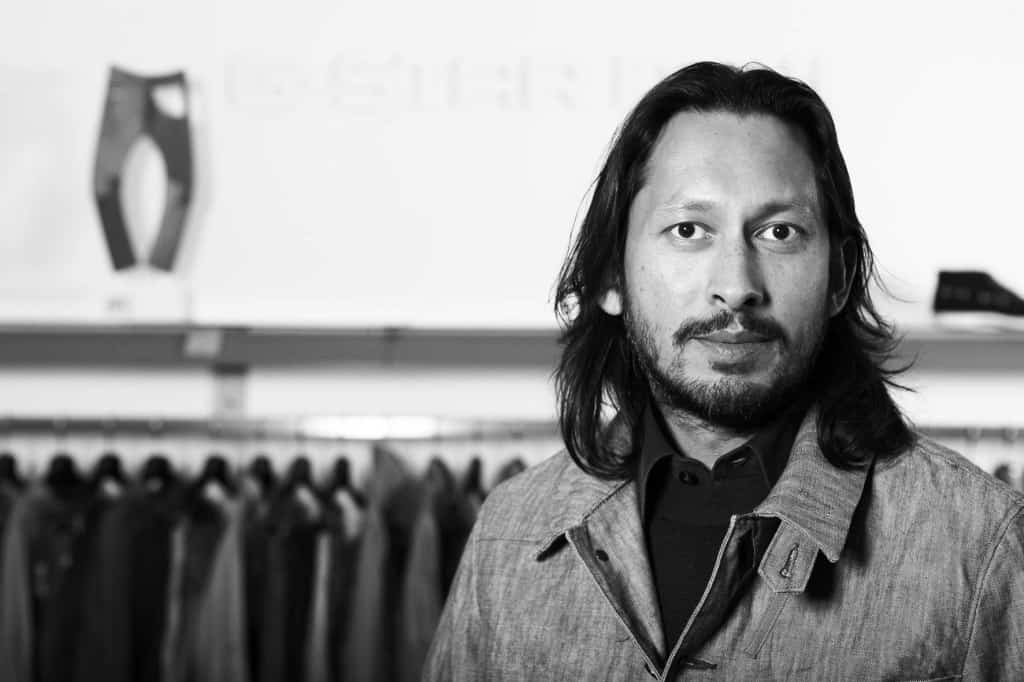“When you’re young you have more ego, you want to maintain your idea or agenda, through any creative process. When you’re older and have had a bit of practice, you give up on this, because you have a belief that innovation is this collaborative process.” Shubhankar Ray, Brand Director G-Star Raw
Shubhankar Ray was born in 1968 in Calcutta, India. After graduating from Manchester University in 1989 with a Chemistry Bsc (Hons), Ray has spent the last 20 years re-inventing numerous global fashion & lifestyle brands around the world like G-Star Raw, Camper, Levi’s, Caterpillar, Stride and Travel Fox, as well as adhoc projects for Sony, The United Nations and Prince Charles’ Charities. His work is based in global branding, consumer-social reality and designing multi-level communications systems including international advertising campaigns, TV spots, short films, magazines, gallery installations, music, web and shop systems. Ray is mostly known for his innovative long running global campaigns and brand image created for Caterpillar in the 1990s, Camper during the 2000’s and now G-Star since 2006. He has been global creative director at both Camper & Caterpillar and is currently global brand director at G-Star.
Ray’s work and films have also been shown in the world’s most known galleries and museums including the Design Museum in London (2005), Victoria Miro Gallery in London (2005), Centre for Contemporary Culture in Barcelona (2002), Museo Del Mar in Barcelona (2002), V&A museum in London (2000), Venice Biennale (1999) and Atlantis Gallery in London (1999). He has received numerous advertising & design awards including, Cannes Lions Cyber shortlist (Europe 2004), D&AD (UK 2004, 2002), Premios Laus (Spain 2004, 2003, 2002), Emma Award (UK 1999). He also lectured widely on Creativity, Visual Communications and Branding at Oxford University, as well as other institutions in London, Los Angeles, Barcelona, Bangkok, Berlin, Milan, Munich and Cape Town.
In 2006 he joined G-Star Raw, the Amsterdam based street wear to luxury denim brand, as Global Brand Director. His collaboration with G-Star covers creating new concepts and new ways for the brand to communicate worldwide. He’s mainly responsible for global brand image, message, positioning, strategy and new ideas. Ray oversees all of G-Star’s marketing worldwide.
THC: What inspires you and why?
Shubhankar: I grew up in the northeast of England, a typical immigrant childhood of the 70’s. I moved to Manchester to attend University because all my favourite music came from there, and I spent a lot of time at a music venue called, The Hacienda, where I worked & played in the 80’s. I saw a lot of stuff bubbling : back then it was called “underground” culture, which was only at The Hacienda. You’d go there as a fan of New Order or Joy Division, and end up infected by all the other stuff you saw there, like the early days of Oasis, Stone Roses and Happy Mondays. They were just cool guys in this audience of avant-garde individualistic people who wanted either to be in a band or just pray at a temple for youth culture. Fast-forward a few years, and underground became mainstream. This influenced me a great deal in what I do now. In Manchester, you’d grown up with whatever John Peel was playing on BBC Radio 1, but The Hacienda popularised segregated music, like reggae, hip hop and later acid house. At eighteen, I thought that because I was surrounded by all that music, I could get a job making or working with music. Noel Gallagher, Ian Brown and guys like that thought they could, too. They went off and made it their reality with Stone Roses and Oasis. At twenty-one, I realized there’s a thousand people all better than me making music. I see this feeling of self-doubt less so now. This ability to dream or succeed…if you can harness it, keep going. Don’t stop believing, even if people don’t like it.
THC: How did you get into your business?
Shubhankar: I went to University to be a scientist. Nestle funded the research institution. They didn’t want good graduates to leave, so they offered me an MBA course. I thought, two days a week, another round at university, not bad all ‘round. While I was doing the MBA, I was seconded to the marketing department, working with Ogilvy & Mather and J. Walter Thompson, then the two biggest advertising names in London. I worked on Kit-Kat and Aero. In the early 90s, Levi’s were looking for their first brand managers for image & design in Europe and by a mixture of serendipity and good fortune, I ended up working there. I got through the selection process, I think, because I knew a lot about music. Then Levi’s Head of Marketing Roy, he loved music, too. I started out working with the advertising agency BBH on TV commercials. Those adverts later became part of popular culture. It started with Nick Kamen taking his jeans off in the launderette, and then it cut to Marvin Gaye playing in the background. This became part of a dialogue, with the image turning into a cultural icon, whilst using quite a scientific or political propaganda mechanism, cutting in “I Heard it Through the Grapevine”. Nobody else was doing that, so it became huge and 501 the jean of the 1980s & 1990s. Each of the Levi’s advertisements had a musical element, be it Babylon Zoo or Stiltskin who reached No1 in the charts. Most advertising involves interruption, the start of a movie at the cinema, throughout TV shows. It’s all about interrupting what you are doing. The smart way is to wait for the audience to be receptive. The idea is to say, “when you’re ready, I will show you something.” The less the audience are shown, the better the strategy works because they will want to find out more. With complex messages containing purpose or cause, it’s better the customer or audience is inspired to find out more, then you tell them. Content only works when the context is right.
THC: What are you working on right now?
Shubhankar: We’re involved in Parley & Pharrell Williams’ Bionic Yarn on “Raw for the Oceans”. We’re making denim out of recycled ocean plastic. There are three counter weights in the campaign and its cause: “The world’s first denim made out of recycled plastic bottles.” It’s a very sophisticated multi-stakeholder project mixing art + science + fashion + music : Pharrell is a big star, so he’s the accelerator. Simultaneously, you can construct an idea…that polyester has been used by the clothing industry for a long time. It takes a lot of plastic manufacturing to produce polyester. Rather than making new polymers from scratch, we can collect and recycle ocean plastic pollution from the beach, where 10% of the beach is full of plastic debris. This can be re-used combined with cotton and spun into a new yarn, which recycles that very plastic, negating the need to create more. And when you put it through a big brand, you can mobilize that audience, not as consumers, but fans. They’re smart young people with much more environmental sensibility and ethics than four generations ago, when marketing began so they can appreciate sustainable solutions and future proofing fashion.
THC: How do you see your space evolving?
Shubhankar: I don’t know and I try not to think about it. History has taught me that life is like being in an ocean. The waves can rise from nowhere, three meters high and batter you. You can’t think too much about the future because you’ve got to navigate through the waves. You have this crazy high-speed accelerated culture, a couple of kids, a wife and work all thrown in. The wife and kids are good practice for the working aspect, because you don’t know when, suddenly from the calm sea, there’s a four-meter wave coming. I’ve been married twenty years, so you can imagine, I’ve been swimming in those choppy seas many a time. Everything needs to be relatively sustainable. That said the future is moving into more sustainable directions, especially for traditional old industries like clothing mills or newspapers. If left unaddressed now, the market or cultural force will send shockwaves through the industry. I have to encourage my daughter to read the newspaper but also to recycle & re-use. It has taken a long time to condition her, because they swipe everything on the iPad.
THC: Who is your hero or icon?
Shubhankar: Dennis Hopper. I was a huge fan when I went to see him for the G-Star RAW Icon idea. It was a great honour for me to meet him. Every day he’d give me advice – about women, kids and usually what not to do. One day, he told me something I didn’t understand until after he died. “You’ve always gotta keep moving man, gotta keep moving.” He saw his directing and acting as just as a job. During the 60’s with Warhol, he took photographs. That was his real passion. Now, those photographs are in the Royal Academy. Meeting him was pretty random. I sent an email to his agent, who happens to be English and who happens to know a friend of mine and asked her if she could pass a message to Dennis. It was a stupid email about fashion shows and how to hijack them with Lars Von Trier style acting & dialogue without a set or location. I never thought he would write back and invite me to his house. I was so nervous, I woke up at 6am in Venice Beach. The meeting was at 11am. I couldn’t sleep, couldn’t eat, had to walk up and down the beach twenty times. Most things don’t make me nervous, but this did. He was just so nice aswell as inspiring. We crafted an idea in his kitchen. I would record him, dress him, he’d also let me take photos of him next to his artworks. The owner of G-Star, Jos, said he wanted to get a celebrity, and I suggested not to do it in an obvious way with a hot young A-list star and perhaps we use an older guy who was a legend. Dennis was just great. For a year, we were collaborating in America. He’d take me for cups of tea. We’d sit there in a Julian Schnabel-designed interior, and he’d question me about works of art, because we both liked Jean-Michel Basquiat. That’s a lot, for a guy of that magnitude to share genuine time with me. I met my hero and I only have more respect for him.
THC: What is your favourite spot around the world?
Shubhankar: London. I love Camden where I live. We moved from London and lived in Spain for a little bit. I think you have to leave somewhere and return to really love it. I love parts of Shanghai, New York, Los Angeles…I love some aspects of Japan and China. Culturally, I love the samurai code, ethics and of course, the food and Japanese karaoke. I always loved travelling when we were kids. We never really had any money to buy houses, cars or a colour TV, but we always had money to travel. My father was an anthropologist, so we travelled to strange places like Yugoslavia or Sweden in the 70’s. We stood out as an Indian family, my mother in a sari and my father journeying around Europe. I’ve always been up for travel. I got married in the Caribbean. I love it there, partly due to the reggae and cricket!
THC: What is your favourite injection of culture into a brand?
Shubhankar: Accessible cultural references from art, music and film, blending attributes of a culture at its most relevant. A lot of it is about being well-referenced and knowing what to recycle and when. Tarantino is super well-referenced with great timing & taste in music so it all comes together in his films. He can read culture well, because he’s not trained so is part intuitive and part fan. He has a natural inclination for knowing the right moment for a movement to resurface. It’s a blend of genius timing and interesting subject matter. He understands that innovation is a process that involves lots of different people. He knows how to integrate things. This is another key indicator about one’s propensity to collaborate with the right people. When you’re young you have more ego, you want to maintain your idea or agenda, through any creative process. When you’re older and have had a bit of practice, you give up on this, because you have a belief that innovation is this collaborative process. It’s a blend of hard work with human pursuit and you are a part in a system of innovation.









